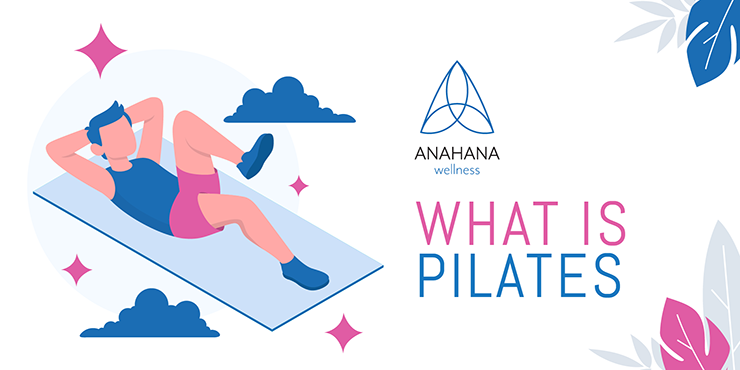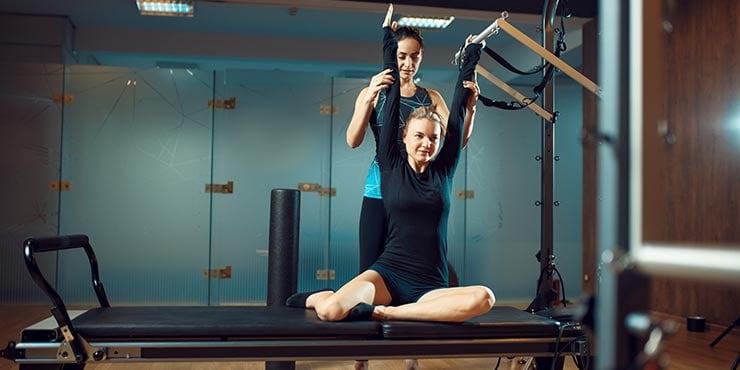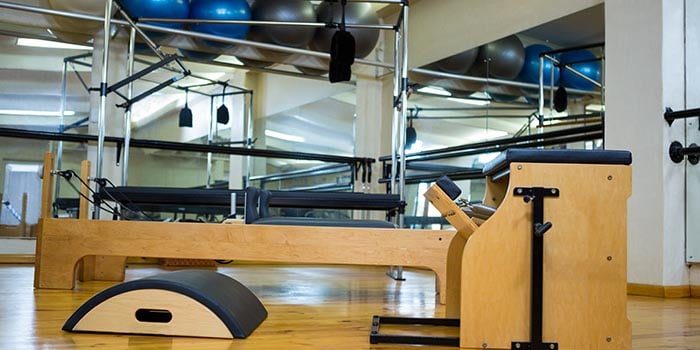Pilates
The Pilates method is the practice of low-impact mind body exercise that aims to strengthen muscles while improving posture and flexibility. Pilates...
The Pilates method is the practice of low-impact mind body exercise that aims to strengthen muscles while improving posture and flexibility. Pilates classes are safe for all abilities and ages. It can be practiced at home or in a studio with a Pilates instructor and may or may not include props depending on the type of practice.

It is an exercise system that was developed by Joseph Pilates. The practice includes controlled movements involving the entire body focusing on the core muscles. These can be performed on a reformer, a mat, or with other equipment.
The Pilates method can improve overall health. Instruction on breath work accompanies the different exercises to support the mind-body connection. Other pilates moves are used to improve flexibility, strength, posture, mental health, and more.
Joseph Pilates invented and developed the pilates training method, originally called Contrology. Joseph was born in Germany in 1883. His father was a well-known gymnast and his mother a naturopath.
From a young age, Joseph was in and out of the hospital. He had various medical issues, including asthma, rickets, and rheumatic fever. These left him with significant muscle weakness.
As a young man, Joseph aimed to cure his physical impairments. He did this by learning and practicing a range of exercise regimes to build strength and improve his overall well-being. He used everything from weight lifting and boxing to yoga and gymnastics. This led him to work as a professional boxer and even to travel with a circus.
During World War I, he used his skills as a physical fitness expert to help wounded soldiers. He developed a new type of physical therapy that involved their hospital beds. These would later become the initial prototypes for Pilates reformers.
Joseph’s new exercise program was highly successful. He decided to take it with him when he moved to America in the 1920s. While in New York, he opened a Contrology studio with his wife Clara. They began teaching what would become the standard Pilates workout to new converts.
Joseph’s Pilates instructor training program was the first of its kind. The first to learn the program went on to spread it through their teachings.
Pilates spread far and wide. A studio can now be found in virtually every major city in America.
There are many certification programs available, but the teacher training is not standardized to become a qualified instructor. It is recommended that the individual should first practice and become familiar with the types of Pilates that they want to teach.
Once familiar, the individual would find a reputable certification program. One that has a wide-ranging and comprehensive curriculum. Some of the well known teacher training programs are STOTT PILATES, Balanced Body, Fletcher, Basi, Equinox, and Club Pilates Teacher Training.
It is important to understand the origins of Pilates, how it evolved, and its basic principles. This includes learning the anatomy and physiology of the body. To be a good instructor, an individual will also need to learn the long list of Pilates exercises and how to teach them effectively to students.
One significantly famous Joseph Pilates quote reads as follows:
“Physical fitness can neither be achieved by wishful thinking, nor outright purchase."
- Joseph Pilates
This means to obtain physical fitness and general well-being it has to be worked for. The work is well worth it though as there are many benefits. Even with Pilates classes for beginners, practitioners can see the benefits almost immediately regardless of current fitness levels.
Improved joint mobility: It helps the overall function of the body by changing the soft tissues surrounding the joints which can better their movement.
Improved flexibility: It increases the range of motion by lengthening the soft tissue surrounding the joints.
Better balance and posture: Increasing the strength of the musculature that makes up the core provides a stronger base for the arms and legs. This helps with overall body stability.
Reduced risk of injury: Improving strength, flexibility, and overall health decrease the chance of injury during day-to-day activities and while being active.
Improved core strength: Includes strengthening muscles in the abdomen, back, and surrounding the hips. These muscles provide the foundation for the movement of the arms and legs and play a role in posture.
Improved body strength: By doing controlled movements utilizing the body's muscles, the body is strengthened. This involves the muscles of the trunk and those in the arms, hips, and legs.
Deeper, fuller breathing and better lung capacity: Focusing on breathing with each movement and expanding the rib cage when inhaling helps improve lung function. It also aids with stress relief by helping the body relax.
Enhanced muscle tone: Higher repetitions and holding positions focus more on the endurance of the muscle than the size.
Increased stamina: This occurs due to having to hold different postures and having to control the movement throughout the practice.
Improved back pain: This can be done by decreasing muscle imbalances through strengthening and lengthening muscles with control.
Deeper concentration: This increases the focus on each movement, ensuring body alignment is maintained throughout the practice and helps foster the mind-body connection.
Improved mental clarity and focus: This plays a role in stress relief and mental health. The increased ability to focus also helps with being present both during practice and during other activities.
More pelvic floor strength: By strengthening the other muscles making up the core, the pelvic floor musculature will also strengthen and have increased endurance.
 While Pilates can be performed on a mat without special equipment, props can always be used to enhance a workout.
While Pilates can be performed on a mat without special equipment, props can always be used to enhance a workout.
These range from complex machines like Cadillac reformers to small objects like rings. The following is a list of equipment that may be used in a Pilates class:
Reformer: A bed-like structure used for more advanced movements. Includes a sliding carriage and various bands, bars, and pulleys.
Cadillac: A stationary structure comprised of a table and a tower. Also known as a trapeze table.
Tower: The frame that sits atop a special table to form the Cadillac. Includes various bars, bands, hand rings, and pulleys for acrobatic movements.
Table: The mat/bed portion of a Cadillac. Unlike a reformer, the table does not have a carriage that slides.
Pilates socks: Low ankle socks with silicone markings on the bottoms for added grip and stability. Made of breathable fabric ideal for exercise.
Chair: A chair that can be used for modified Pilates moves. It features handles as well as one side that sits against resistance springs. This can be used as a large pedal for strength training and other moves.
Wheel: A circular ring with flat sides. Used for stability training and to enhance or modify activity.
Ring: A ring with two parallel handles that is used to add resistance to arm and leg activities. Also known as a circle or a magic circle. (Note: ring exercises are different than those with a wheel.)
Mat: A mat similar to a yoga mat but thicker. This provides additional cushioning for rolling and side work.
Bar: A covered bar that is sometimes weighted. It is often used with bands to add resistance.
Barrel: A covered partial barrel-shaped piece of equipment with or without a ladder attached. Used as a prop for the spine when doing postures with gravity.
Spine corrector: A covered partial barrel-shaped piece of equipment with a step or ledge on one side. Used to support the spine while working on regaining and maintaining its curvature. Allows the spine to strengthen and elongate.

The reformer machine and its variations were invented by Joseph Pilates. Reformers are not necessary for the practice of Pilates, but they are sometimes used in place of mats.
A Pilates machine or reformer usually resembles a bed with a sliding mat on top (called the carriage). Reformers often feature straps, springs, bars, and pulleys.
The Cadillac is the most advanced piece of equipment available. It is a raised mat (resembling a bed) with a tower over top.
Together, the two structures create a machine that looks like a canopy bed. Pulleys, straps, and bars hang from the tower to help with various exercises.
Reformers are mainly used in a Pilates class at a studio. They can also be purchased for home use, but due to their high cost buying a reformer for home use is an investment.
Pilates and yoga are often grouped as if they are the same form of exercise method. This is due to movement similarities. Especially when comparing mat Pilates and yoga. In actuality, they are quite different from one another.
To begin, the practice of yoga is far older than the practice of Pilates. Yoga originated in India thousands of years ago while Pilates only came about in the early 20th century.
It has also been argued that yoga focuses more on the mind and spirit while the Pilates method tends to focus more on the physical body.
Despite these differences, there are many similarities. Both practices improve overall wellness including both mental and physical health.
Many people use either or both practices to gain more flexibility, strength, and stability. Both practices can also help with body weight, muscle tone, and muscle imbalances.
There are many variations of each practice. Depending on the skill level and physical health of an individual, there will always be a yoga and Pilates practice that will fit their needs.
Stabilizing and strengthening the core muscles are an integral part of the Pilates method. In every class, most of the exercises will involve the abdominal muscles and back muscles significantly. There is a reason for stressing these muscles. This is because strong core muscles improve body control, balance, and strength. They are also associated with good posture. As the word implies, the core is at the center of everything regarding physical fitness.
Pilates is for everyone, including beginners. If someone is just starting and looking for a new physical wellness routine to try, it is a great option. That is because it is simple to begin, easy to modify, and can be performed anywhere. This includes small spaces. A typical beginner's workout might only involve mat moves and postures. Props and equipment are sometimes used, but they are not necessary.
Pilates can be practiced at home or in a class setting similar to yoga classes. Taking a beginner's class, such as the famous Pilates 100 or private lessons can be a great way to learn the different exercises. In-person classes also allow for tactile feedback to be provided. This can be a good form of feedback while doing mat work or other forms of Pilates to help improve postural alignment and body awareness.
These exercises for beginners are truly foundational, so learning them right away is useful. Exercises can always be modified or made more difficult to meet an individual's needs or fitness level.

The typical Pilates definition can sometimes put older adults off, but it can be an excellent form of exercise for them. Often they are discouraged because the practice can involve complicated movements that require considerable strength.
The good news is that not all Pilates exercises are like this and there are many options. For instance, many classes focus on pilates for seniors.
Having a Pilates body before starting this practice is not a prerequisite. It is much better to commence as a beginner and go slow especially if the individual is a senior. Progressing slowly can decrease the risk of injury and discomfort.
Pilates is an excellent practice for back pain such as low back pain. This is true because most of the movements focus specifically on improving the strength of the core muscles, and back discomfort is often caused or exacerbated by poor core strength. Core muscles include both the abdominal muscles and the back muscles. Pilates as a therapeutic exercise is beneficial for those struggling with lower back discomfort.
Lower back pain is a frequent symptom of pregnancy. Many pregnant women enjoy prenatal Pilates as a drug-free therapeutic solution to their back discomfort. It is a special type of practice that reduces the overall intensity of each movement. It also commonly features movements to curb lower back pain.
Prenatal Pilates can also be a great idea for women who simply want to stay in shape during pregnancy. At the same time, it is always important to take extra care when performing any fitness routine while pregnant. The same goes for those with non-pregnancy back discomfort.
Pilates is an excellent exercise session and solution for chronic back discomfort, to increase muscle strength when performed correctly. If not, it can exacerbate the problem. The best way to stay safe and reduce back discomfort is to work with a qualified instructor and receive continual instruction from experts only. Always ensure to pay close attention to maintain proper alignment and never push too far.
Runners often attends several pilates sessions weekly to improve their performance. This is because the benefits are the same requirements for optimal running performance: core strength, balance, and breath work. It is also excellent for injury prevention.
Running requires strength throughout the muscles of the core for prolonged stability. Runners can control and produce more force and better endurance with a strong core.
Likewise, a strong core gives runners better balance, greatly reducing the risk of injury. This also provides the legs and hips with a strong base to move from. Overall, the strong musculature that is created also helps with injury prevention.
Finally, it helps runners tremendously with endurance by improving runners’ breath control through breath work. Each exercise corresponds to a breathing pattern.
This persistent controlled breath work exercises the lungs and increases lung capacity. That means runners can run faster for longer and do not fatigue quickly.
It is a type of exercise focusing on core strength, flexibility, and postural alignment. It is low impact, but advanced classes can be quite challenging. It focuses on working the entire body including the back, rib cage, hips, pelvic floor, and inner thighs.
Pilates for men and women is virtually the same. The main differences between classes are the overall skill levels and what types of props and equipment are used (if any).
It is good for improving flexibility, strength, muscle tone, and posture. Pilates is especially good for improving the strength of the core. It also plays a role in mental health by decreasing anxiety and aiding in stress relief.
There is a range of different classes and programs for advanced practitioners, but there are also many exercises for beginners.
It provides a workout that focuses on strength, flexibility, and mobility. It is not a form of traditional cardio.
Practice at home is usually performed on a mat while many Pilates classes may involve reformers and mat exercises. Reformers are also available for home use.
When it comes to yoga vs Pilates, a Pilates workout is generally considered to be more vigorous than yoga. Yoga is usually more gentle and more fluid. Pilates also focuses more on core work and strength training. It has less of a spiritual element than yoga.
Furthermore, while both practices can use props, only Pilates utilizes reformer machines. Breath work is important in both as well, but yoga tends to focus more on meditation and mindfulness.
Yes, it can certainly help with body weight. Most notably, a weight loss class will help an individual build lean muscle and muscle tone. Take a look at any Pilates before and after photo and muscle improvement can be seen in the after pictures.
It may help lower BMI. It will make muscles look leaner and can help give the flatter “Pilates abs” appearance. At the same time, the practice may not be the best choice for rapid or significant fat loss. That occurs more with cardio exercises.
Pilates: What It Is, Benefits, and More
Introduction to Pilates-Based Rehabilitation
The effect of Pilates exercise on body composition in sedentary overweight and obese women
Yoga and pilates in the management of low back pain | SpringerLink

The Pilates method is the practice of low-impact mind body exercise that aims to strengthen muscles while improving posture and flexibility. Pilates...

Pilates is a form of resistance training that originated in Germany. Joseph Pilates created it in the 1920s for rehabilitation for war soldiers, and...

There is an extensive range of Pilates equipment on the market today. Some pieces include reformer boxes, Pilates sticks, rollers, and Pilates...